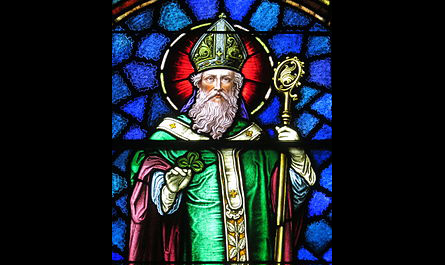By Deacon Sal
March 17th, popularly known as Saint Patrick’s Day, is believed to be his death date and is the date celebrated as his Feast Day. This day became a feast day in the Catholic Church due to the influence of the Waterford-born Franciscan scholar Luke Wadding, who was a member of the commission for the reform of the Breviary in the early part of the 17th century.
For most of Christianity’s first thousand years, canonizations were done on the diocesan or regional level. Relatively soon after the death of people considered very holy, the local Church affirmed that they could be liturgically celebrated as saints. As a result, Patrick has never been formally canonized by a pope (which was common for saints before the 10th century); nevertheless, various Christian churches declare that he is a saint in Heaven, and he is still widely venerated in Ireland and elsewhere today.
Born in Roman Britain, he was captured by Irish pirates at the age of 14 during a raiding party and taken to Ireland as a slave to herd and tend sheep. At the time, Ireland was a land of ancient Celtic cultures and Pagans, but Patrick turned to God.
His captivity lasted until he was twenty, when he escaped after having a dream from God in which he was told to leave Ireland by going to the coast. There he found some sailors who took him back to Britain where he was reunited with his family.
A few years after returning home, Patrick saw a vision that prompted his studies for the priesthood. He was ordained by St. Germanus, the Bishop of Auxerre, whom he had studied under for years, and was later ordained a bishop and sent to bring the Gospel to Ireland.
Patrick arrived in Slane, Ireland on March 25, 433. There are several legends about what happened next, with the most prominent claiming that he met the chieftain of one of the ancient Celtic tribes who tried to kill him. After an intervention from God, Patrick was able to convert the chieftain and preach the Gospel throughout Ireland. He converted thousands there and began building churches across the country.
He often used shamrocks to explain the Holy Trinity, and entire kingdoms were eventually converted to Christianity after hearing Patrick’s message.
St. Patrick preached and converted all over Ireland for 40 years. He worked many miracles and wrote of his love for God in Confessions. After years of living in poverty, traveling, and enduring much suffering, he died March 17, 461 at Saul (now in the county of Gloucestershire, England) where he had built the first Irish church. He is believed to be buried in Down Cathedral in Downpatrick, which is a town in Northern Ireland. His grave was marked in 1990 with a granite stone.
Sources: Catholic Online and Wikipedia

